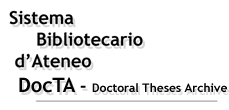|
|
DocTA - Doctoral Theses Archive >
Tesi di dottorato >
SCUOLA DI DOTTORATO IN SISTEMA AGRO-ALIMENTARE >
Citazione:
Utilizza queste indicazioni per citare o creare un link a questo documento.
|
Gregori, Rossella. "ROLE OF THE PLANT-PATHOGEN CROSS TALKING IN FUSARIUM MYCOTOX IN PRODUCTION AND MASKING IN MAIZE", Università Cattolica del Sacro Cuore, XXVI ciclo, a.a. 2012/13, Piacenza, [http://hdl.handle.net/10280/2476].
|
| Titolo: | ROLE OF THE PLANT-PATHOGEN CROSS TALKING IN FUSARIUM MYCOTOX IN PRODUCTION AND MASKING IN MAIZE |
| Autore/i: | GREGORI, ROSSELLA |
| Tutor: | BATTILANI, PAOLA |
| Coordinatore: | ALBANESE, ANTONIO |
| Lingua: | ENG |
| Abstract in inglese: | In this work we investigated the in vivo and in vitro ecological conditions that can favour the fumonisin production, both free and hidden forms, in the maize-Fusarium verticillioides pathosystem. Samples of different maize hybrids have been collected from dough to the harvest maturity to follow the trend of fungal incidence and both fumonisin forms contamination, but also the changes in chemical composition. Differences in the level of contamination have been found among hybrids during the growing season. Furthermore, the production of fumonisins has been found correlated to the total lipids content, another parameter that changed during the growing season. This finding underlined the existence of a relationship between toxin contamination and fatty acids composition of the hybrids.
Recently the existence of a cross talk between plant and pathogen has been demonstrated, based on some oxidized signal molecules (oxylipins) produced from fatty acid precursors. This result was also confirmed by the molecular analysis on the in vitro pathosystem that showed differences in the activation of the genes involved in plant and fungal oxylipins production during the incubation time.
Also post-harvest contamination of maize was investigated in this study, with particular attention to the effects of the drying treatment, a common post-harvest practice aimed at decreasing the water availability, and to the storage capacity of a new low cost storage system, silo bag. The drying treatment was showed to affect fumonisins content, in particular an increased fumonisins contamination was detected after heat treatments. This increment seemed to be produced by chemical changes of matrix components, caused by high temperature, that produced the release of hidden fumonisin in free form.
Silo bags were shown to be an effective system to store cereals because no significant change occurred in fungi or toxins contamination during a 9-month storage. Therefore, being more flexible and less expensive than traditional store houses, they should be very useful for farmers. |
| Digital Object Identifier (DOI): | http://dx.doi.org/10.1016/j.foodcont.2012.06.033 |
| Data di discussione: | 19-feb-2014 |
| URI: | http://hdl.handle.net/10280/2476 |
| È visualizzato nelle collezioni: | SCUOLA DI DOTTORATO IN SISTEMA AGRO-ALIMENTARE
|
File in questo documento:
| File |
Dimensioni | Formato | Accessibilità |
|---|
| Tesi_Gregori.pdf | 2,61 MB | Adobe PDF | Visualizza/apri
|
|
Accesso e utilizzo dei contenuti di DocTA
|



